IBM partnered with Public Procurement Canada to modernize legacy systems and improve pay transparency. The initial scope focused on designing a new web portal for 300,000 employees to access their pay and benefits, MyGCPay. However, my work uncovered systemic issues shifting the project toward scalable solutions for managers, HR teams, and help desk workers. MyGCPAY has received news recognition for its impact on government modernization.
I was initially brought on to design the pay stub dashboard, but my role evolved to lead designer. I scaled the MyGCPay ecosystem to address downstream pay issues by designing a suite of digital solutions from 0→1 within the 'HR-to-Pay' pipeline.
Reworking content: a shift from storefront to online shopping
Public Procurement Canada sought to alleviate ongoing pay issues affecting federal employees. The initial goal was to improve pay transparency by creating a new dashboard, MyGCPay, for staff accessing their pay and benefits information. However, after learning about common pain points from employees across different departments, I discovered that pay issues cascaded downstream.
Managers were burdened with manually gathering contract and entitlements data from multiple systems for employees—some overseeing up to 100k reports. This process significantly impacted accuracy.
Employees acting in multiple roles had to manually piece together their pay and benefits by reaching out to various managers and department-designated HR teams.
Employees did not always understand the meaning of paystub terminology or reasons behind deductions or pay adjustment breakdowns. This led to a surge in help desk calls and service delays.

Designing for downstream pay issues
Challenge 1
How might we empower employees to find, understand, and verify their pay information to reduce the backlog of help desk tickets?
Challenge 2
How might we improve pay accuracy by giving managers timely oversight to employees’ job, contract, and schedule information?
Streamlining workflows & building bridges
My work began with paystub dashboards but evolved into something much larger. As recurring payroll errors revealed deeper systemic gaps, I pivoted toward research and service design to uncover how issues propagated downstream—and how we could design interventions earlier in the process.
I was heavily involved in improving organization-wide collaborations and workflows between departments and leadership within the Public Procurement Canada ecosystem.

Using research to bridge misaligned expectations & understandings
Over the course of 6 months, we conducted 154 contextual inquiries with employees from different roles and departments to understand organizational gaps related to pay processing. From our findings, we mapped out patterns and interdependencies that highlighted systemic challenges within the organization.
I co-facilitated a workshop that brought different departments and roles together in one (MURAL) room to find common ground on root issues. It was important to adopt a co-design approach to build shared ownership of the solution.

Balancing breadth & depth: break-out rooms with individual departments
We established break out rooms to give each department time to validate their current workflows and challenges. Afterwards, the departments reconvened and shared their concerns. This gave us an idea of where to prioritize design efforts.

Translating behind-the-scenes workflows into digital solutions for better collaboration
I bridged organizational silos with a service blueprint by defining and highlighting previously invisible workflows. The blueprint became a shared artifact that, for the first time, showed hidden administrative work downstream the HR-to-pay pipeline. This helped align teams and informed future modernization strategies.

Seeing the solution at a glance
Over two years of design work went into shaping the MyGCPay dashboard and its supporting pages. Here’s a look at some of the key features we brought to life:
Employee data at their fingertips
The MyGCPay dashboard gives employees a clear snapshot of their payee information, tax documents, pay issue tickets, and benefits details—all in one place.
Managing multiple paystubs and roles
Employees can now stay on top of their pay across overlapping acting positions in one consolidated view. They have access to pay breakdowns and past earnings—something they had to previously track on their own.
Bringing transparency to pay case tracking
The two-step triage of processing pay issues has become more transparent to users. Employees can now follow their inquiry from submission to escalation, seeing exactly when it transitions into an active case. By revealing each stage of the process, we helped build greater trust and confidence in how their pay concerns are being handled.
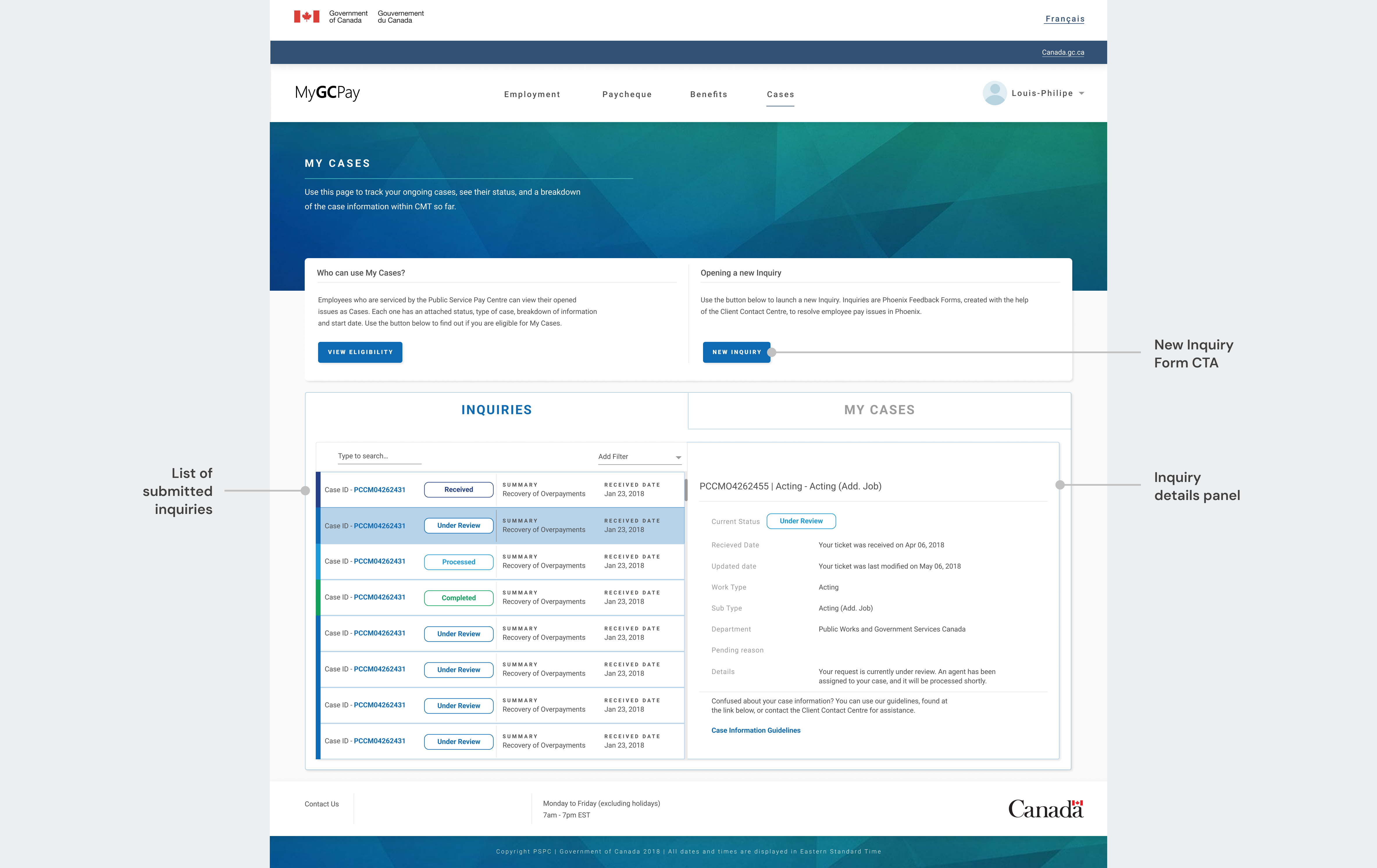
Balancing AI & human support
We designed the chatbot to handle routine questions and guide employees through policies, HR-related forms, or existing tickets with minimal friction. Strategic prompts acted as checkpoints, ensuring employees were handed off to live staff without breaking the flow of the conversation.

Building the modular design system
We adopted a bento-style approach to design the dashboard and its residing card components. Cards contained information relating to employment, benefits, and pay that could be understood at a glance.
✴ This allowed for the addition of new cards as more information becomes available
✴ I quickly scaled the design to include a manager dashboard from just creating new card components
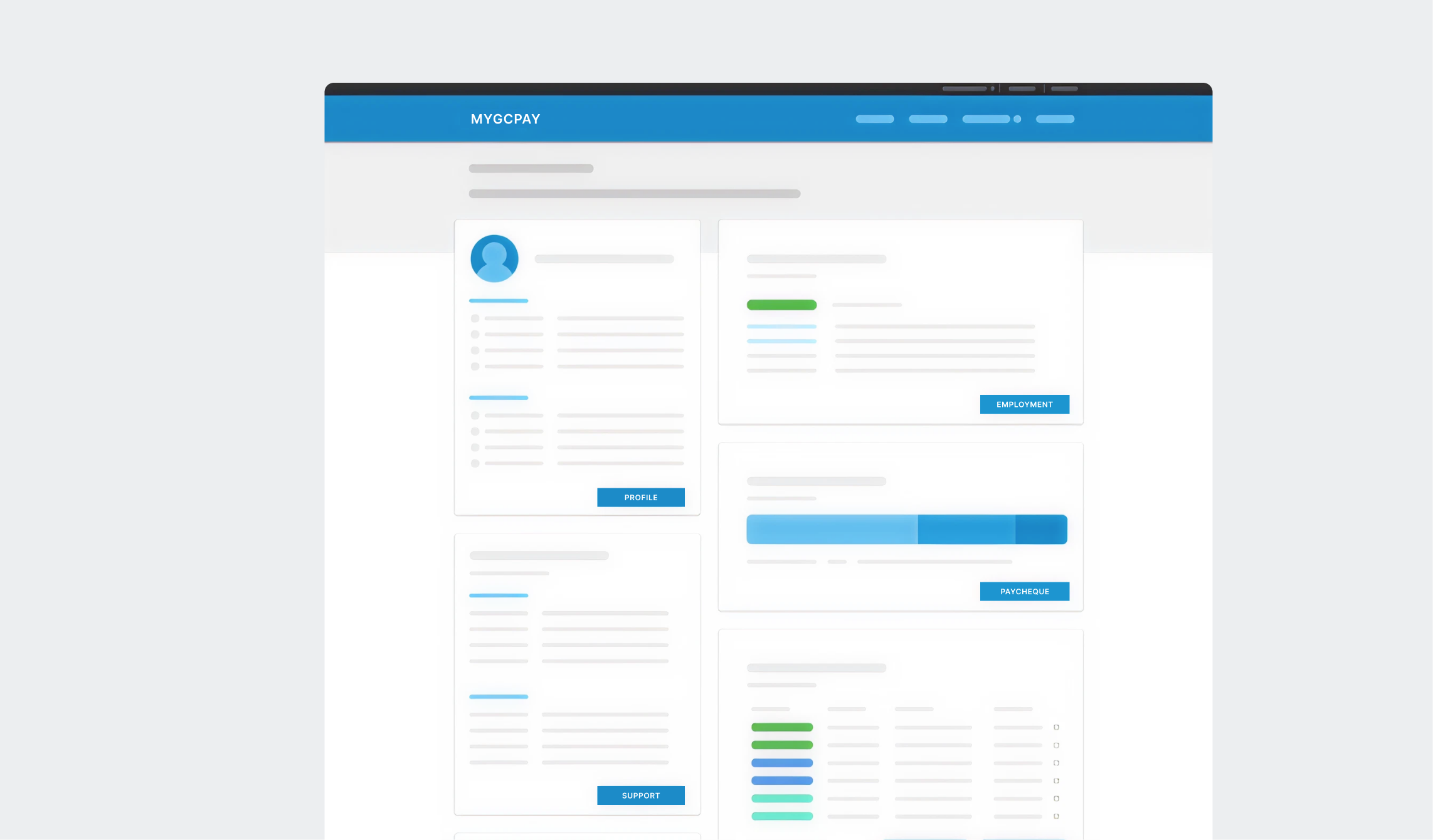
Extending the design system to the manager dashboard
Managers now have a view of key employee details—such as job transfers, contract dates, and leaves of absence. Instead of querying data across legacy systems, managers could focus on proactively supporting their employees.

Making data more accessible
Accessibility was a core requirement for MyGCPay, which needed to comply with WCAG AAA standards to support employees of all abilities. We ran audits with the JAWS screen reader to confirm that information hierarchy, data tables, and dynamic content were fully perceivable and operable for keyboard users.
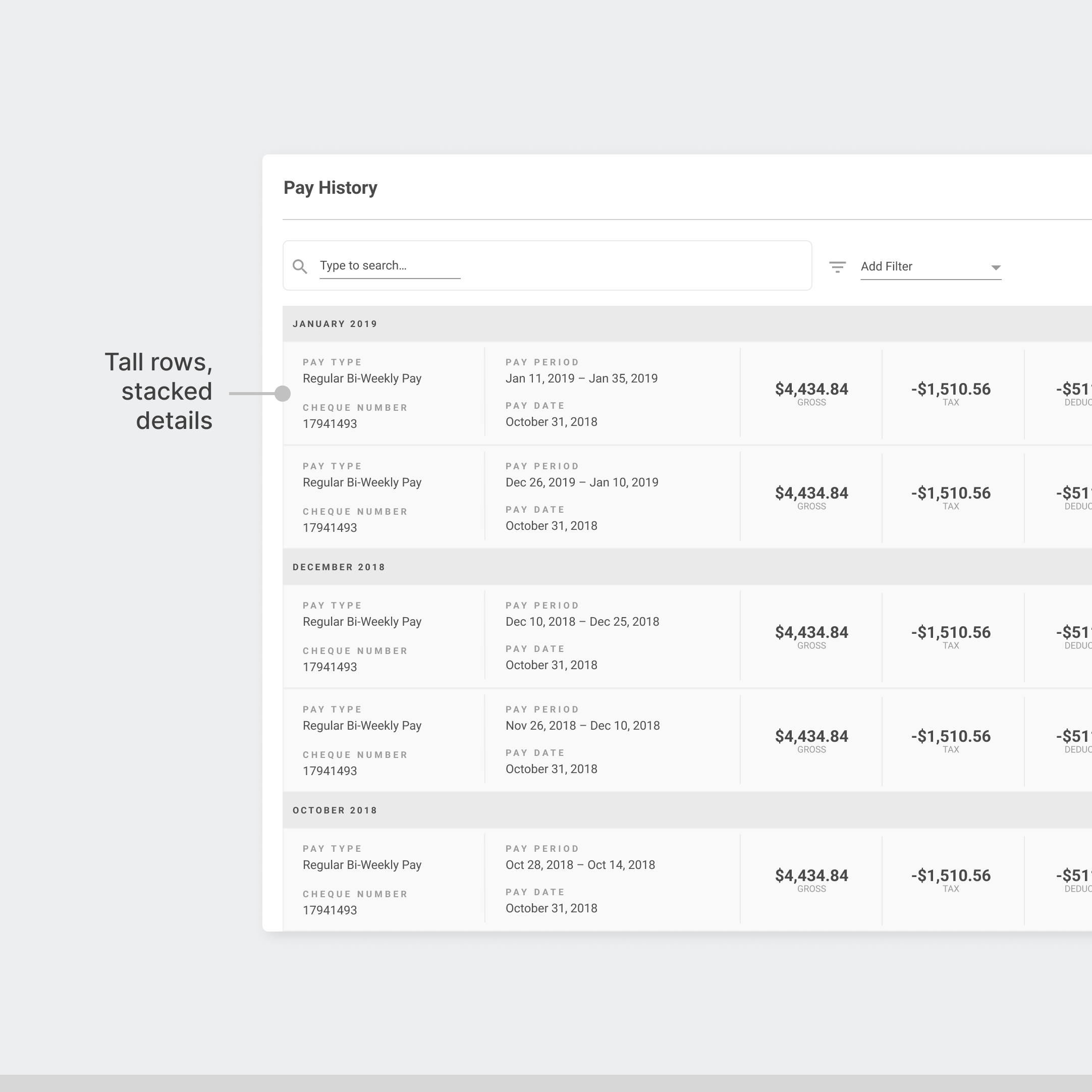
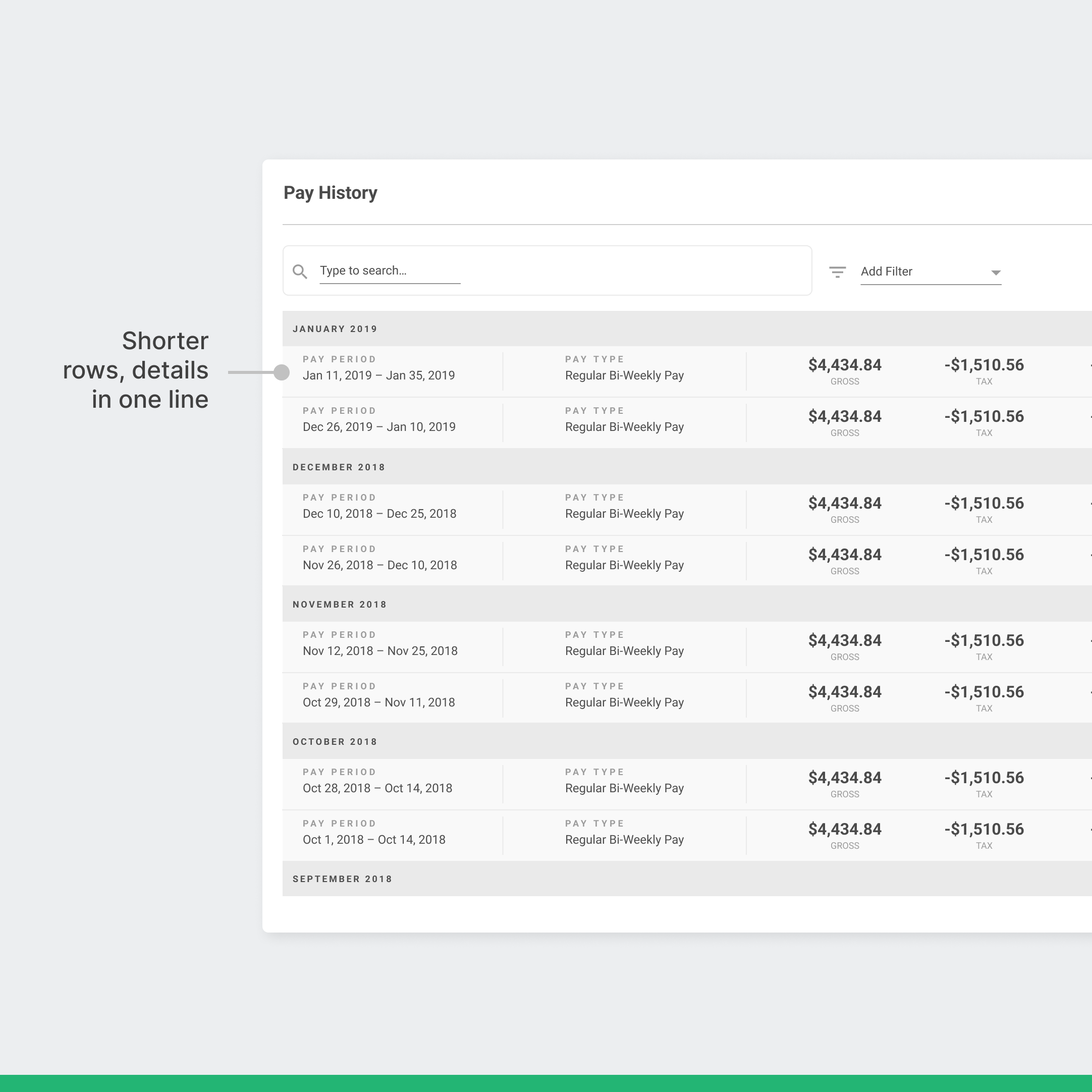
Before
Each pay history entry displayed multiple stacked details within a single list item. While visually comprehensive, this layout was difficult for screen reader users to navigate, as information could be read in a confusing order in too much detail.
After
We simplified the structure so that each pay history entry appeared on a single row. This improved screen reader navigation. Additional details could be accessed through a link, allowing users to open a modal with more information without losing their place in the table.
A success story
With a successful roll-out to 330,000 federal employees, the initiative strengthened pay transparency and reduced pay issue tickets across the public service sector. This led to faster case processing, improved operational efficiency, and empowered employees, ultimately strengthening IBM's relationship with the federal Canadian government.
Other accomplishments
I repurposed data from a shelved project into a 0→1 design initiative
The solution won the 2020 Best Cloud Innovation in Canada award and was recognized by IBM for Innovation and Delivery Excellence.
Most importantly, MyGCPay earned support from real users—leading to positive national news coverage and kudos on social media (see below ↓)
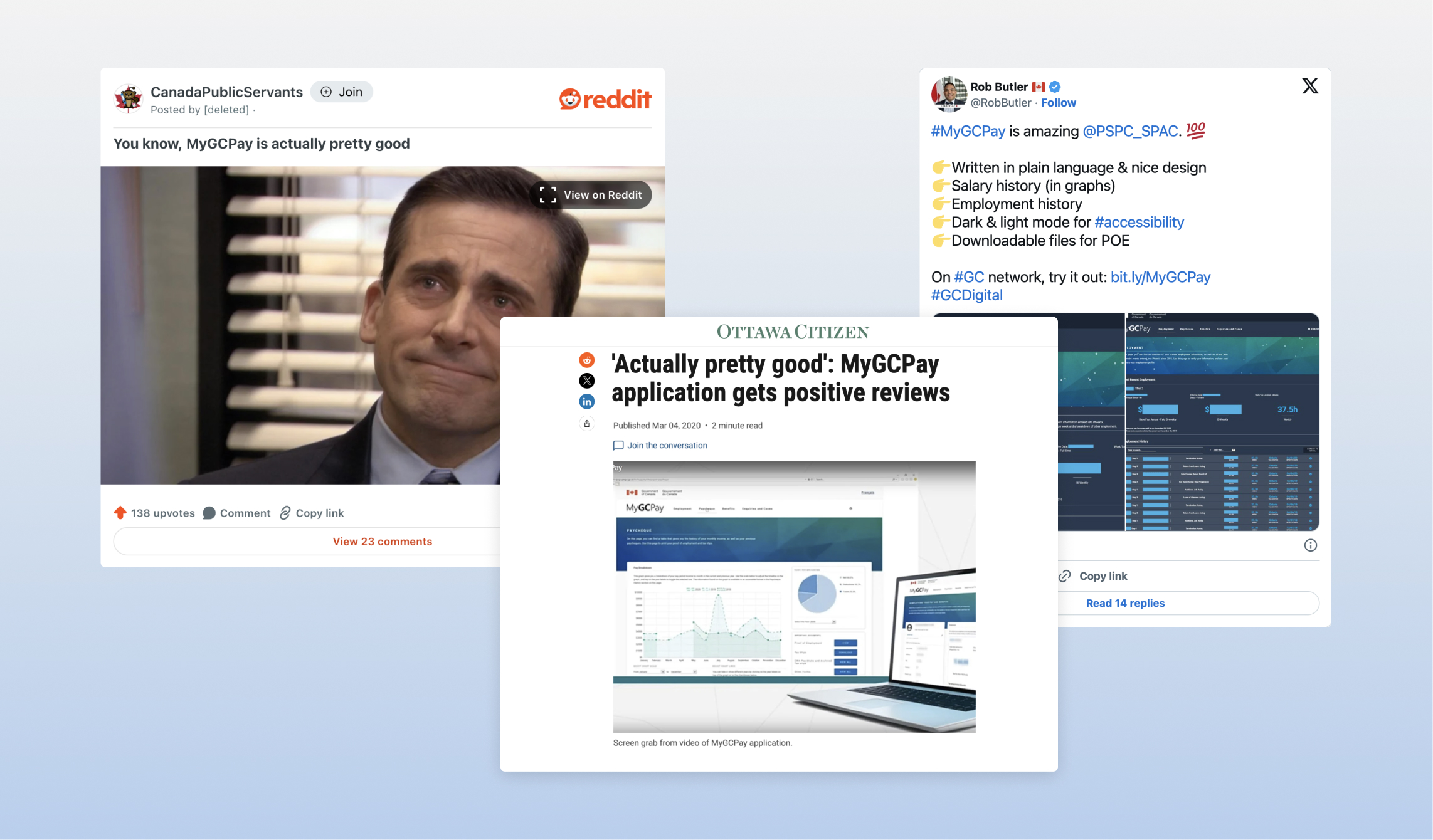
By creating a space for open dialogue, we were able to align on business goals early and build shared momentum around a unified project direction.
I found that design thinking workshops clarified misaligned expectations, but also showed the power of structured collaboration.
Involving users in co-designing personas proved invaluable, as it allowed them to share personal insights indirectly—without the vulnerability that can come with one-on-one interviews where they might fear being judged on their work.





